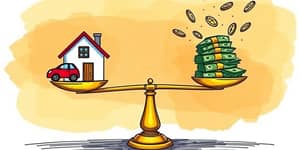Purchasing or refinancing real estate is one of the most significant financial decisions many people will ever make. Mortgages provide the capital needed to acquire a primary residence, vacation retreat, or commercial property. With diverse products available, understanding their structures and applications empowers buyers to make informed choices. This guide explores the major types of mortgage products, key considerations, and practical tips for selecting the right loan for your goals.
Understanding Mortgage Basics
A mortgage is a loan secured by real estate collateral. Borrowers agree to repay the borrowed amount, called the principal, along with interest, over a set term. If payments are not met, lenders can foreclose on the property. Common term lengths range from 5 to 40 years, with 15 and 30 years being the most popular.
Monthly payments typically cover both principal and interest, though some products allow for special structures where only interest is paid initially. Choosing between fixed and adjustable rates, government-backed or conventional options, hinges on personal financial circumstances and long-term plans.
Conventional Mortgages
Conventional loans are not insured or guaranteed by any government agency. They can be conforming or jumbo, based on limits set by Fannie Mae and Freddie Mac. These loans serve as the backbone for most home purchases and refinances across the country.
- Down Payment: Usually 3%–5%, with 20% down to avoid private mortgage insurance.
- Credit Score: Minimum 620 required, though higher scores secure better rates.
- Debt-to-Income: Ratios up to 50% including housing costs are acceptable.
- Loan Limits: Up to $766,000 in most regions; higher in high-cost areas.
For many buyers, a conventional mortgage offers predictable monthly payments and budgeting benefits and opportunities to refinance for even lower rates when market conditions improve.
Government-Backed Mortgages
Government-backed loans reduce barriers for first-time buyers, veterans, and rural residents by offering flexible qualifications and lower initial costs. These programs are supported by federal agencies, which eases lender risk and delivers savings to borrowers.
- FHA Loans backed by the Federal Housing Administration require as little as 3.5% down for credit scores of 580 and higher.
- VA Loans guaranteed by the Department of Veterans Affairs often require no down payment or mortgage insurance for qualified service members.
- USDA Loans issued by the U.S. Department of Agriculture are available with no down payment for eligible rural buyers meeting income limits.
These programs serve unique populations, enabling homeownership with competitive interest rates for veterans and low down payments and credit scores that would be challenging under conventional requirements.
Fixed-Rate and Adjustable-Rate Mortgages
Fixed-rate mortgages feature an interest rate that remains constant for the life of the loan, while adjustable-rate mortgages (ARMs) adjust periodically after an introductory fixed period.
Common fixed terms include 15 and 30 years, delivering stable long-term budgeting confidence since monthly payments never change. This option is ideal for buyers who plan to remain in their home for many years.
ARMs, such as a 5/6 ARM, start with a lower fixed rate for five years before resetting every six months. This structure offers borrowers greater flexibility for short-term stays or those anticipating income growth or future refinancing.
Jumbo and High-Balance Loans
When property values exceed conforming limits, jumbo and high-balance loans fill the gap. Jumbo loans, which exceed $766,000 in 2024, require more stringent approvals, including larger down payments and stronger borrower profiles.
Applicants must meet higher credit score and income requirements and often demonstrate significant cash reserves. These products are tailored for financing luxury homes or second residences in high-cost markets.
High-balance loans operate similarly but apply where local conforming limits are increased due to regional housing prices. Both loan types ensure buyers in expensive markets can secure the financing they need.
Specialized Mortgage Products
Beyond standard loans, specialized mortgages address particular financial strategies or life stages. While these can be powerful tools, they also carry distinct risks.
Options like interest-only loans involve paying only interest for a period, which can increase payment shock when principal becomes due. Reverse mortgages unlock equity for seniors without monthly repayments, repaid when the home is sold or transferred.
Key Terms and Considerations
Understanding mortgage terminology is essential. Principal refers to the loan amount, while interest is the cost to borrow. Private mortgage insurance (PMI) applies to conventional loans with down payments under 20%. The debt-to-income ratio measures monthly debts against gross income. Closing costs are fees paid at settlement, typically 2%–5% of purchase price. Foreclosure occurs when a lender reclaims property due to nonpayment.
Uses of Mortgage Products
Home mortgages support a range of financial goals:
- Purchasing primary, secondary, or rental properties.
- Refinancing to reduce interest rates or change loan terms.
- Accessing home equity for renovations or debt consolidation.
- Investing in commercial real estate or vacation homes.
- Utilizing government programs to overcome credit or down payment barriers.
Choosing the appropriate product ensures financing aligns with personal and investment objectives, maximizing the value of real estate assets.
Market Trends and Shopper’s Checklist
In early 2025, 30-year fixed mortgage rates generally range from 6% to 7%, while ARMs often start lower. The conforming loan limit stands at $766,000 for most of the U.S., with higher thresholds in select counties. Down payments vary from 3% to 20%, depending on the program and borrower profile.
Before applying, assess your credit score, debt-to-income ratio, and savings for a down payment. Determine whether fixed-rate stability or ARM flexibility best suits your timeline. Investigate eligibility for government-backed loans like FHA, VA, or USDA. Compare Loan Estimates from multiple lenders to weigh rates, fees, and servicing quality. Finally, evaluate your intended length of residence and potential plans for refinancing or sale to align your mortgage decision with long-term goals.
Conclusion
Selecting the right mortgage product is pivotal in achieving homeownership and investment aspirations. By exploring conventional, government-backed, fixed-rate, adjustable-rate, jumbo, and specialized loans, borrowers can find financing that matches their financial profile and goals. Armed with knowledge of key terms, market trends, and practical strategies, you are now prepared to navigate the mortgage landscape confidently and secure a loan that empowers your journey.
References
- https://www.consumerfinance.gov/owning-a-home/explore/understand-the-different-kinds-of-loans-available/
- https://www.bankrate.com/mortgages/types-of-mortgages/
- https://www.investopedia.com/terms/m/mortgage.asp
- https://www.lendingtree.com/home/mortgage/types-of-mortgage-loans/
- https://www.schwab.com/learn/story/types-of-mortgage-loans
- https://www.rocketmortgage.com/learn/types-of-mortgages
- https://www.consumerfinance.gov/consumer-tools/mortgages/answers/key-terms/
- https://myhome.freddiemac.com/blog/homebuying/understanding-common-types-of-mortgage-loans










